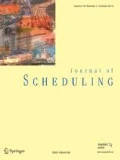Abstract
We consider the following list scheduling problem. We are given a set \(S\) of jobs which are to be scheduled sequentially on a single processor. Each job has an associated processing time which is required for its processing. Given a particular permutation of the jobs in \(S\), the jobs are processed in that order with each job started as soon as possible, subject only to the following constraint: For a fixed integer \(B \ge 2\), no unit time interval \([x, x+1)\) is allowed to intersect more than \(B\) jobs for any real \(x\). It is not surprising that this problem is NP-hard when the value \(B\) is variable (which is typical of many scheduling problems). There are several real world situations for which this restriction is natural. For example, suppose in addition to our jobs being executed sequentially on a single main processor, each job also requires the use of one of \(B\) identical subprocessors during its execution. Each time a job is completed, the subprocessor it was using requires one unit of time in order to reset itself. In this way, it is never possible for more than \(B\) jobs to be worked on during any unit interval. In this paper we carry out a classical worst-case analysis for this situation. In particular, we show that any permutation of the jobs can be processed within a factor of \(2-1/(B-1)\) of the optimum (plus an additional small constant) when \(B \ge 3\) and this factor is best possible. For the case \(B=2\), the situation is rather different, and in this case the corresponding factor we establish is \(4/3\) (plus an additional small constant), which is also best possible. It is fairly rare that best possible bounds can be obtained for the competitive ratios of list scheduling problems of this general type.
Similar content being viewed by others
References
Garey, M. R., & Johnson, D. S. (1979). Computers and intractability: A guide to the theory of NP-completeness. New York: W. H. Freeman.
Graham, R. L. (1966). Bounds on certain multiprocessing anomalies. Bell System Technical Journal, 45, 1563–1581.
Graham, R. L. (1969). Bounds on multiprocessing timing anomalies. SIAM Journal on Applied Mathematics, 17, 416–429.
Leung, J. Y.-T. (Ed.). (2004). Handbook of scheduling. Boca Raton: Chapman and Hall.
Acknowledgments
The authors would like to thank David Johnson and the referees for helpful suggestions. This research was supported in part by Grants DFG BR 2272/7-1 (O. Braun), ONR MURI N000140810747, and FA9550-09-1-0900 (F. Chung), NSF 10050729 (R. Graham)
Author information
Authors and Affiliations
Corresponding author
Rights and permissions
About this article
Cite this article
Braun, O., Chung, F. & Graham, R. Single-processor scheduling with time restrictions. J Sched 17, 399–403 (2014). https://doi.org/10.1007/s10951-013-0342-0
Received:
Accepted:
Published:
Issue Date:
DOI: https://doi.org/10.1007/s10951-013-0342-0




